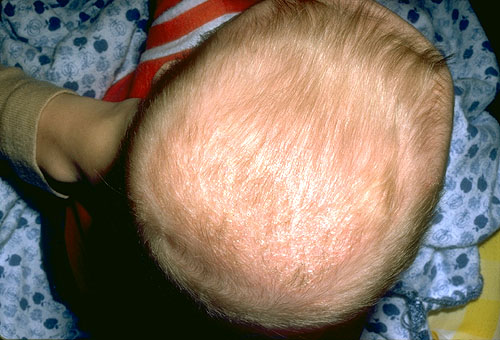Cradle cap
Cradle cap is a patchy, greasy, scaly and crusty skin rash that occurs on the scalp of recently born babies. Cradle cap is infantile seborrhoeic dermatitis that is confined to the scalp. Infantile seborrhoeic dermatitis may also affect other areas of the body such as behind the ears, in the creases of the neck, armpits and nappy area.

What causes cradle cap?
The cause of cradle cap is not clearly defined but it is not caused by infection, allergy or poor hygiene. Possibly it has to do with overactive sebaceous glands in the skin of newborn babies, due to the mother's hormones still in the baby's circulation. The glands release a greasy substance that makes old skin cells attach to the scalp as they try to dry and fall off. There may be a relationship with skin yeasts (malassezia).
Who is at increased risk of cradle cap?
No particular baby is more at risk than any other. Cradle cap is a very common condition that usually appears within the first 6 weeks of life. In some cases the condition will slowly resolve itself over a few weeks while in others it may continue for 6 to 9 months, and sometimes much longer.
What are the signs and symptoms of cradle cap?
Cradle cap is characterised by greasy, yellow, scaly patches over the scalp. In some cases a thick scaly layer may cover the whole scalp. Over time the scales may become flaky and rub off easily. The condition is usually not itchy and in most cases babies are unaware of the problem.
What is the treatment for cradle cap?
Treatment of cradle cap is with mild baby shampoos. The scalp should be washed regularly and this, along with soft brushing, should help to remove the scales. We recommend Pot of Gold skin balm rubbed on the affected area will help to soften the scales, and may also heal the effected area.
If the cradle cap doesn't improve with frequent washing or if the rash spreads to other areas, your doctor may prescribe a medicated shampoo containing ketoconazole, and hydrocortisone cream for any inflamed or reddened areas.
What is the prognosis?
Cradle cap is not a serious condition and is only temporary. It usually clears up by the time the child is 6 to 12 months old but may occasionally persist for longer. Seborrhoeic dermatitis may then occur again after the child reaches puberty.
A different form of dermatitis, atopic dermatitis (infantile eczema), often develops as the cradle cap is improving. Atopic dermatitis generally continues for several years and is very itchy.
Original material provided by the New Zealand Dermatological Society Inc. (DermNet NZ), and reviewed by everybody, August 2005.
|